 For several weeks now we’ve been
For several weeks now we’ve been subjected to entertained by rehearsals for You’re A Good Man, Charlie Brown here in the Reinventorium, another fringe benefit of having an office colocated with PEI’s premiere venue for musical theatre.
Like Anne and Gilbert that almost killed us kept us in rollicking good spirits last summer, this means that one must be able to do complex digital work while “okay, again, from the top… You’re a Good Man, Charlie…” rolls over and over and over and over again a mere 15 feet from where you type.
Fortunately, I’ve been able to find my way there, and more than once I’ve found myself gaily whistling the chorus on my way to lunch.
One thing you gotta understand about this production of Charlie Brown: it’s no half-baked amateur production. This is professional musical theatre that is – as I can well-attest better than anyone who’s not in the cast – rigorously rehearsed by a top-notch crew of performers. It will be good and you should probably by a ticket right now.
Sadat’s Cuisine is a new restaurant in Charlottetown just opened at the corner of Grafton and Cumberland, across from Holland College. It’s located in a space occupied by various convenience and grocery stores over the years (most famously Bassett’s) but now completely transformed, at least on the inside, into a bright, clean comfortable couple of rooms.
Sadat’s advertises itself as offering “Middle Eastern Halal food with fresh local Island products” and the menu, indeed, is populated by mix of new (for Charlottetown) and familiar offerings: samosas, kabobs, rice dishes, soups:

The front room offers tables and chairs; the back room cushions and low tables (you leave your shoes before entering). While it looks daunting, that’s where I choose to sit for the lunch I shared there with my friend Lee this afternoon for my first visit:
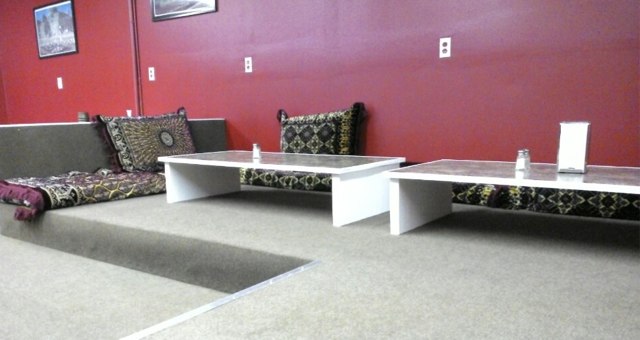
The service was friendly and accommodating to a standard rarely encountered in Charlottetown; the food was tasty and all made from scratch. We both enjoyed the samosas as a starter and the Fesenjan, described as “sweet and sour pieces of tender boneless chicken with walnuts and pomegranate juice,” which was particularly good and a new sort of flavour for this city.
Sadat’s is open 7 days a week from 11:00 a.m. to 10:00 p.m. and I suggest you drop in; pull up a cushion in the back room and stay awhile. I think you’ll be glad you did.
(For more information and news, follow Sadat’s on Facebook or Twitter).
Here’s my new Prince Edward Island license plate. I paid the $10 premium to support conservation (hence the red fox) and get the special 3-letter variety (the standard is 5); the LHO was what got pulled out of the plate bucket at random, but I like it.

I’ve written in the space about PEI license plates before and their “someone sketched something on the back of a napkin and suddenly it was the design” quality and this new design is no exception; there are no less than 9 graphic elements on the plate:
- Raining red maple leaves in the top-left.
- Province House.
- Canadian flag in the bottom-left.
- Prince Edward Island flag in the bottom-right.
- The red fox (granted, that was my choice).
- The words “Prince Edward Island.”
- The word “Conservation.”
- The words “Birthplace of Confederation.”
- The small map of PEI.
It’s most decidedly from the “cram in as much as we can” school of graphic design.
Most confounding, to my eye, the “Prince Edward Island” and the “Conservation” are set in two distinct typefaces, something you can see clearly by comparing the lower case i, a, s and n in a magnified image:

Without taking away from my commitment to conservation and the letters L, H, and O, my real reason for opting to pay an extra $10 for the conservation plate was to avoid the misuse of the armorial bearings of the province a glorified hyphen:

That was not only one-graphic-element-too-many, but the bearings are rendered much too small to be legible and, more importantly, much too small given their importance as a provincial symbol.
All of this is more graphically tragic given the heights to which PEI license plates have risen in the past. Take 1973, for example:
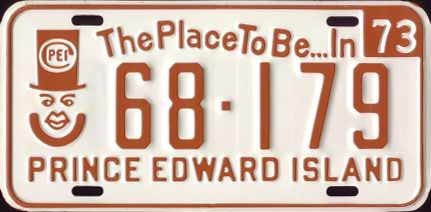
Was there ever a greater license plate design? Simple: a single graphic element, plus typography.
And the standard green-on-white that followed and was in place up until the unfortunate Anne situation, was similarly solid and uncomplicated (and, with its simplfiied crest, very much of the design of the times):
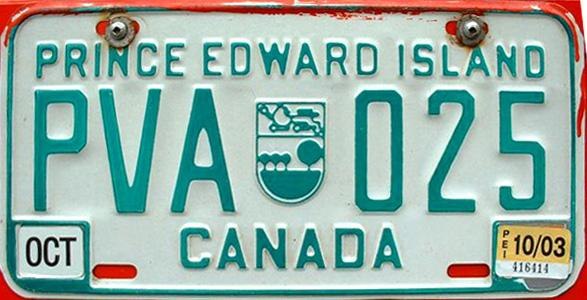
Meanwhile, I’m left to deal with a fox creeping up on Province House.
My paternal grandmother – we called her “Nana” – died in 1999 at the age of 84. We were fortunate to have her visit us here on Prince Edward Island several times after we moved here, and it was so long ago that her visits serve, among other things, as a reminder of just how many epochs we’ve been here.
I remember visiting Nana at her house in Brantford when she was in her late 70s. We went out to dinner and when she was having her coffee once the meal was finished I watched her put milk in it.
I had never known her to have milk in her coffee; indeed both she and my parents would always order “black coffee,” to the point where I just assumed that’s what “coffee” was called.
“Why have you started drinking milk in your coffee?”, I asked.
“Well,” she replied, “I decided to try it one day and I liked it, so I started.”
That one incident has served me well in the years since, reminding me that it’s never too late to try new things, even things you never though you’d like.
In that same light, I really enjoyed this advertorial film from Vodafone about the first airplane flight of two Dutch women. Thanks to Neal Gillis for pointing me to it.
Back when Oliver was in elementary school I resolved that if any member of our household was to become involved in the Home and School association it would be me; Catherine is an inveterate, dedicated volunteer and I was certain that, if she were to be the one, we would wake up shortly thereafter and she’d be running the whole show (believe me, it’s happened before).
I resolved that I would “take one for the team,” so to speak, and this is how I ended up sitting around a table in the staff room at Prince Street School with a bunch of strangers talking about how to raise money to buy window blinds for classrooms that didn’t have them.
One thing led to another and, irony of ironies, eventually I agreed to act as treasurer for the Prince Street Home and School and then, a series of horse trades later, as President.
Somewhere in there, Wendy MacDonald, then serving as Past-President of the provincial PEI Home and School Federation, and a dedicated former Prince Street home and schooler herself, casually asked me if I’d be willing to put my name forward as a candidate for regional directory for the provincial body.
Wendy is one of the smartest minds on PEI, and not someone whose requests you take lightly; she’s not pushy, she’s simply straightforward.
And so I said yes.
And one thing led to another and, irony of ironies, eventually I agreed to act as secretary for the PEIHSF and then, a series of horse trades later, as Vice-President.
Nobody is more surprised than I that I not only participate in home and school but that I actually enjoy it and have become a passionate believer in the power of home and school as an actor in the education system.
Which is how, I suppose, I ended up with my name put forward for the position of President yesterday. There being no contrary-minded, by the end of the day I joined a group of dedicated new and returning directors as part of a new board for the PEIHSF.
I’ve written in this space before why I find home and school so attractive; yesterday’s experience at our annual meeting was no different: we considered eight resolutions, each of which was developed and put forward by a local home and school, on topics ranging from lice to technology. There was vigorous discussion on each, and democracy was coursing through the air.
Later in the day there was a similarly-vigorous discussion with the Hon. Alan McIsaac, Minister of Education and his Deputy Minister Sandy MacDonald and with English Language School Board Chair Fred Osborne and the board’s Director of Curriculum, Doug MacDougall. While not everyone’s questions were answered, the transparency was, I think, appreciated by all (and something, I know from discussion with those from other jurisdictions, we are privileged to enjoy).
And so, for the next two year, when Kerry Campbell intros “for reaction from Island parents, I spoke to…” the name will be mine. I’m daunted by the prospect, but also excited: stickhandling a broad-based Island-side democratic organization with a long history is a great challenge and a great honour. I’ll try not to screw it up.
After four days of wall-to-wall music at East Coast Music Week, and a few days to let it all sink in, my favourite discovery has emerged as Gabrielle Papillon, a Nova Scotia singer-songwriter I had the pleasure of seeing, accompanied by large and talented band, at the Pourhouse at the Music Nova Scotia showcase on Saturday night. Listen here:
It suddenly dawned on me, after a year of use, that I hadn’t been properly lubricating my Golding Jobber No. 8 letterpress. I’d been greasing the axel, yes, but I’d completely ignored the little “lubricate here” holes that can be found in every corner of the press.
To drive this point home to myself – and to any others who might suffer the same fate – I printed up some reminder cards:
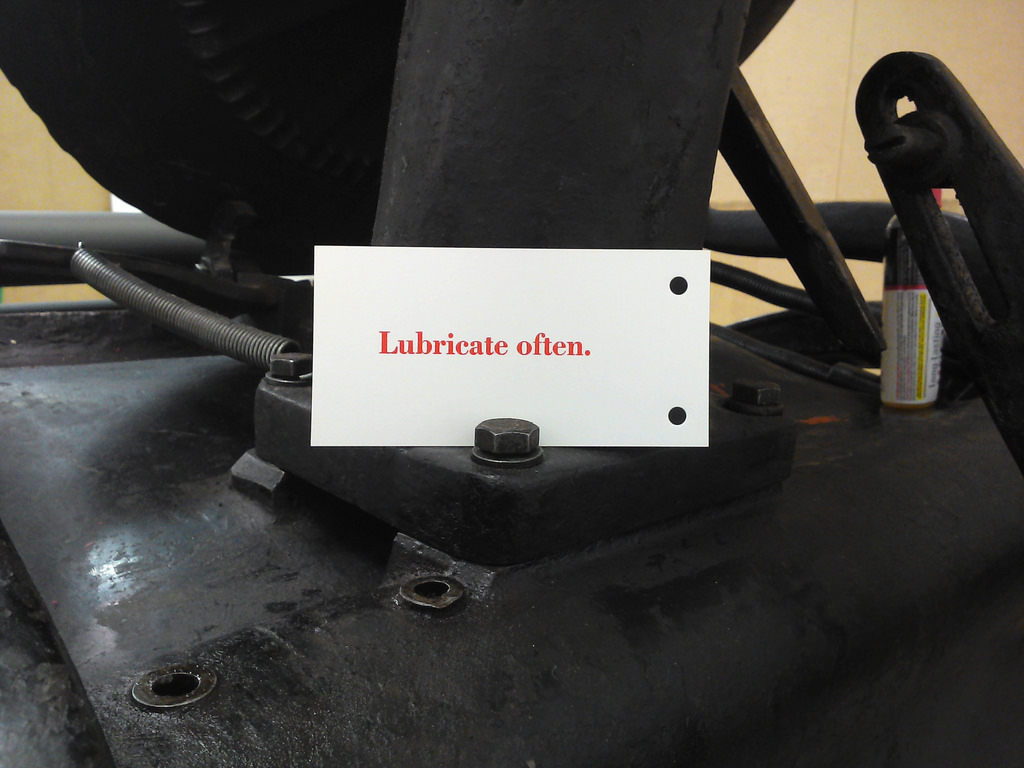
Once the ink is dry, I’ll find a way of making them available to others similarly ill-lubricated.
I turned 48 on Saturday, which we celebrated with breakfast at Kettle Black followed by an enthusiastic shovelling session to extricate our car from the ice and snow. I could swear we were picking strawberries on my birthday when I was a kid, but that’s probably not true; but surely there were never snow banks in April in the 1970s, were there?
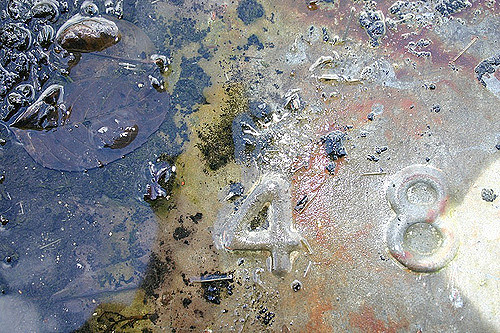
There’s a funny thing that I’ve noticed in the last few years, the kind of thing that get’s punctuated at birthday time: as we all get older it’s like we split off into generational squads, a sort of “shirts and skins” of life, with the people on our team those with whom we share history, pop-cultural references and the degree to which we are shop-worn.
As Fibber McGee and Molly was to my parents, WKRP in Cincinnati is to my squad.
What I didn’t anticipate in all this was the sense of common cause I have with those of, say, plus or minus 5 years. It’s not “kids today!?”, it’s not “I walked a mile and a half to school,” it’s more like a knowing wink, an increased sense of confidence, and the surprise at the sudden realization that, hey, we’re running this thing now.
I notice this most around the Home and School table, an organization that, because it’s composed entirely of parents of school-age children, generally excludes the younger and the older and thus is perhaps the closest we have to a generational clubhouse. Around that table are people with whom, in many cases, I share almost nothing; we’re from different upbringings, have different politics, different life experiences. But we’ve all got kids making brochures about heat pollution and learning about vertices and worrying about the school dance. And that’s enough to join us together, sometimes rather profoundly.
As it happens, I’ve been walking around for the last year thinking, mistakenly as it turns out, that I turned 48 last year. And so this year is like a special secret bonus year. I promise to try and make it worth it.
Photo from Flickr by daren_ck, Attribution 2.0 Generic license.
It’s coming up to the end of East Coast Music Week here in Charlottetown, a yearly celebration, showcase, and conference for the music industry in eastern Canada and, for those of us lucky enough to live in the heart of the downtown of the host city, a fantastic opportunity to see a lot of very good music packed into four days of performances at venues 5-minutes-walk-or-less away.
I was determined that, unlike the last time ECMW was in Charlottetown, I was not going to miss out, so, against all my procrastinatory impulses, I purchased an $80 wristband well in advance, entitling me to access to most everything.
And thus it was, armed with the (excellent) ECMW app on my mobile, I headed out into the night on Thursday to go clubbing. One of the great things about having a wristband is that you can be promiscuous in your habits, jumping genres by just picking up and heading down the street. Over the course of the evening, then, I was able to see Amy & Rachel Beck, Brianna Gosse, Eartbound Trio, Colour Code, Breagh Mackinnon and Dennis Ellsworth in as many venues.
On Friday night, thanks to my generous brother Johnny, who stayed home with Oliver and Ethan, Catherine was able to join me and we headed down to the Delta for the “roots” showcase and saw Ryan LeBlanc, Amelia Curran, Samantha Robichaud, Catherine MacLellan, Chrissy Crowley, Dave Gunning, Mary Jane Lamond and Wendy MacIsaac, and Tim Chaisson. All this accompanied by the culinary stylings of Leo’s Thai Food (chicken basil rice) and the Big Orange Lunchbox (lobster tacos), who saved me, not having had time to grab dinner before, from a grumpy hungry night.
On Saturday night I was back out on my own, with my eyes set on the Music Nova Scotia showcase at the Pourhouse, the craggy little venue atop The Old Triangle. Having been turned away at the same event on Thursday because it was over-capacity, I arrived 90 minutes early only to find the room packed already, with not a seat to be found and most everyone there jealously guarding their turf knowing that they were lucky to have secured a seat. No eye contact, in other words; no “you could squeeze in here.”
I was close to giving up and heading home, but decided to stick it out, find a windowsill, pull out my copy of The New Yorker (brought along for just this purpose) and wait, finding a place to stand once the music started to roll.
I was well into the Talk of the Town, minding my own business when someone approached and called me by name.
“Peter!”, he said.
I looked up. Vague recollection spread over my face, which he recognized. Oh, right, yes.
It was the chap who, when we moved into our house at 100 Prince Street fourteen years ago, we contracted to gut our second floor bathroom and build it back up to modern standards (i.e. no carpet on the floor, no shower head coming out of the side of the bathtub). It was a dusty, complicated job, and, as these things often go, we got to know the crew pretty well. Which is why my interrogator, working as a volunteer in the venue, recognized me and why, eventually, I recognized him.
We chatted for a moment, and, just as he was heading off to his volunteer duties I said “Hey, if you happen to find an extra chair somewhere, I’d really appreciate it.”
Five minutes later he poked his head out with a contraband chair, purloined from the green room (meaning, I assume, that Old Man Luedecke’s sideman was sitting on the floor; which is why I won’t mention my benefactor’s name, lest Old Man Luedecke seek retribution).
With heartfelt thanks, I held onto the chair for dear life and headed back into the fray looking for a place to park it. With luck now on my side, I reasoned that this was no time to be timid, so rather than finding a dark poorly-sightlined corner at the back, I maneuvered myself and my chair right up to the front, set it down in a tiny, convenient patch of floor beside a large enough group that it would look like I was just fitting in, and proceeded to act as if I was supposed to be there, shirking off the imagined barbs of those who’d been camping out for hours just to get a table in the same region.
And I didn’t move for the next 3 hours.
I had a completely unobstucted view of the stage; here, for example, is Gabrielle Papillon and her large retinue of players:

It was a fantastic night of music: Ron Bourgeois (a talented singer-songwriter from Cheticamp), Old Man Luedecke (not, to my surprise, old at all; crackerjack banjo-based duo with a set of irony-tinged songs), the aforementioned Gabrielle Papillon (an unexpected joy) with Jimmy Rankin (a pure pleasure: such an entertainer).
As the night played on I became ever-more-thankful for my luck, as the venue filled up and filled up and people were hanging from the rafters and perched precariously on the floor. By 11:30, with the night, relatively speaking, still young, I headed out, willing my chair to the couple who had been patiently standing beside me for 2 hours; I would have stayed longer, but I needed to ensure I didn’t completely lose my hearing.
I great night at the end of a great week.
And proof that, if you live on the Island long enough, it will reveal its fringe benefits to you at unexpected moments.
Thank you, bathtub.
Right there on the Autism Assistance Dog page at Dog Guides Canada it says this about one of the roles that Ethan might play in our lives:
The bond that develops between the Dog Guide and child allows for increased social interaction for the family and the child.
One thing I didn’t anticipate is that Ethan would lubricate my social interactions, as well as Oliver’s.
It will be six months to a year before Ethan joins Oliver at school every day and so during this period he’s spending his days in my office and Catherine’s studio, and he goes everywhere we do as we wind our ways through our daily routine, which is part of his training to deal with everyday life in Charlottetown in our family.
What I’m finding in my walking-around-town-living-my-life with Ethan routine is that people who never would have paid me any heed now make eye contact, often with a kind, happy smile. It freaks me out a little, as I’m used to anonymously skulking around the city, nervously averting my eyes so as to not engage, and Ethan pretty well makes this an impossible task.
It doesn’t stop with that, either: people talk to me about Ethan. Especially dog people. But everyone. They are curious, they are open, and somehow Ethan disinfects me of the faint odour of “I won’t talk to him because he’s probably a serial killer” that we all wear around with us.
None of this is necessarily a bad thing. Indeed with Ethan in Oliver’s life as he grows through teenagehood, we will, we hope, see significant benefits from that same sort social interaction. It will be great if Ethan can be the icebreaker that allows someone latitude to ask Oliver out to the soda shop for a malted (yes, my conceptions of teenage social life are strongly rooted in Archie). And if Ethan reduces Oliver’s stress enough to the point where he can do the same, even better.
And of course this isn’t all just magic Ethan fairy dust: being more relaxed, more self-assured, more able to navigate the complexity of the universe, must inevitably translate into subtle changes in gait and how one presents oneself to the universe.
If my walking Ethan along Queen Street, head held high and proud and relaxed, is enough to entertain the smiles of the people in my neighbourhood every morning on the way to coffee, signs are good that Oliver and Ethan will go great places together.
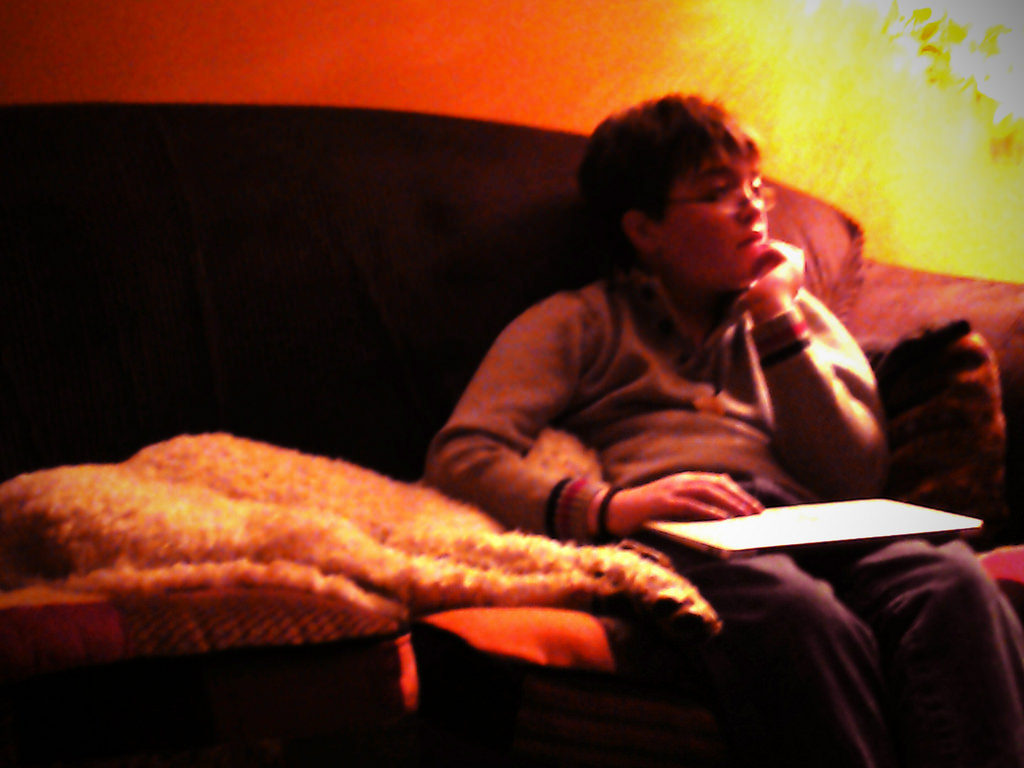
 I am
I am